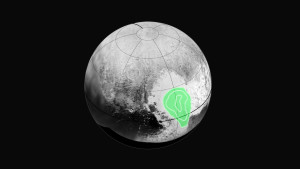Creation Corner
Carbon monoxide on Pluto

The rocket probe New Horizons sent back more pictures from the Pluto system. On Friday (17 July 2015) NASA released some of them. Among them: a frozen lake of carbon monoxide. This lake covers most of the western lobe of Tombaugh Regio (the “heart” on Pluto).
In the days that have followed, neither NASA, nor the Johns Hopkins Applied Physics Laboratory, nor the Southwest Research Institute has tried to explain the carbon monoxide finding. They published a terse caption for the false-color image of the carbon monoxide lake. That caption has a link to another image showing closeups of the floor of Tombaugh Regio. No one seems to want to answer the question: where did all that carbon monoxide come from?
Carbon monoxide chemistry

False-color image of Pluto’s heart-shaped plain (Tombaugh Regio). The western lobe of the “heart” holds a lake of frozen carbon monoxide. Contour lines show increasing concentration toward the center, suggesting a lake of increasing depth. Photo: NASA/JHUAPL/SwRI.
Carbon monoxide forms from the partial burning of wood or coal. With enough oxygen available, wood will burn and release carbon dioxide. But wood burning with a low supply of oxygen will release carbon monoxide instead. According to Wikipedia, Aristotle first wrote that burning coal releases toxic fumes. In fact, an ancient bath, with smoldering coals and all the doors closed, served as the first “gas chamber.” Today, suicide by carbon monoxide poisoning works best by simply starting a car in a closed garage. The engine will release even more of the gas in the closed space than in an open space.
In the wild (that is, apart from “civilization” or even any camp), sunlight acts on certain trace gases to make carbon monoxide. Aside from that, volcanoes release it as a trace gas. And in any forest fire, as the fire depletes the oxygen around it, it releases more carbon monoxide and less carbon dioxide.
Carbon monoxide on Pluto
So how did carbon monoxide form on Pluto? Walter T. Brown of the Center for Scientific Creation gave an answer today. According to the Hydroplate Theory, all trans-Neptunian objects, like all asteroids, comets, and meteoroids, formed from water, rock and mud from earth. A breakout of a subcrustal ocean about fifty miles below ground threw out vast amounts of this material – perhaps as much as four percent of the mass of the earth. The mud and rock included uprooted trees and shrubs from the forests of the early earth.
Pluto and its largest moon Charon formed when a swarm of water, rock and mud accreted to form these two objects. All such accretions released kinetic energy as heat. The heat on Pluto (and on Charon) eventually caused “slushy geysers” to erupt to the surface. Some of these geysers produced the 3500-meter (11,000-foot) mountains at Pluto’s equator.
But the heat, says Brown, also burned the uprooted trees, shrubs, and other vegetable matter that accreted with the other matter (water, rock and mud) to form Pluto. And of course, that burning needed oxygen. Oxygen came from one or both of two sources. Either it escaped from earth with the solids and liquids, or formed when water vapor dissociated in the sunlight of the inner solar system. But burning in a confined space yielded carbon monoxide, not carbon dioxide.
When that gas broke out onto the surface (on Tombaugh Regio), it condensed, then fell as rain into a basin in the heart shape. Then it froze. The published photo shows contours of ever-increasing amounts of carbon monoxide as one approaches the center of the lake. One would expect precisely that when looking down on a lake; the contours in fact show its depth.
As of the time of posting, the New Horizons control and investigation teams have not tried to explain the carbon monoxide. They merely describe it. How they will try to explain it, the world must wait and see.
Reprinted from examiner.com.
Terry A. Hurlbut has been a student of politics, philosophy, and science for more than 35 years. He is a graduate of Yale College and has served as a physician-level laboratory administrator in a 250-bed community hospital. He also is a serious student of the Bible, is conversant in its two primary original languages, and has followed the creation-science movement closely since 1993.
-

 Civilization4 days ago
Civilization4 days agoDC Pipe Bomb Arrest Raises Questions About Christopher’s Wray’s FBI
-

 Civilization5 days ago
Civilization5 days agoThe Legal Logic Behind U.S. Operations Against Narco-Terrorist Networks
-

 Executive5 days ago
Executive5 days agoNewsom’s ‘National Model’ for Homeless Wracked by Fraud
-

 Executive4 days ago
Executive4 days agoWhen You’re in a Hole, Stop Digging
-

 Executive2 days ago
Executive2 days agoWaste of the Day: Obamacare Failed Test, Approved Fraudulent Subsidies
-

 Education3 days ago
Education3 days agoWaste of the Day: Taxpayers Subsidize Football Coach Severance
-

 Civilization3 days ago
Civilization3 days agoPence Calls on Trump To Fire RFK Jr Over Abortion Drug
-

 Executive4 days ago
Executive4 days agoWaste of the Day: Feds Pay Nonprofits That Sue the Government













[…] from examiner.com and from Conservative News and […]
Lester P Gibson liked this on Facebook.
Paul Brundage liked this on Facebook.
David Sullivan liked this on Facebook.
Ted Foster liked this on Facebook.
Interesting theory. Why do you think that there’s carbon monoxide there, though?
I mean, I know why NASA says there is: remote sensing from New Horizons, which supports older findings from remote sensing from Earth which showed CO in the Plutonian atmosphere years ago. But there hasn’t been a sample analysis mission to the surface, so I thought you considered such findings mere supposition, if not an active conspiracy of academic elites.
And where does the methane come from in this theory?
Prediction opportunity: if the CO comes from burning of pre-Flood vegetation, and the methane comes from – what? decomposition of same? – then what should the isotopic makeup of Pluto’s carbon look like? Or the isotopic makeup of the carbon on the Jovian moons, Saturnian moons, TNOs, etc? Bearing in mind that the pre-Flood plant life would not have held anything other than C12, right?
Terrific. Now that I show the dire (for the evolutionary side) implication of the CO finding, you try to deny it.
But I’ll lay that aside. You asked a decent question that deserves a decent answer. What, you ask, would be the isotopic make-up of carbon on Pluto? Most of it would be carbon-12, with maybe a little bit of carbon-13. The tsunami of neutrons cut loose almost at once. That’s why we find deuterium in cometary ices. Still, the proportion of carbon-13 would not be as great as what we see today. Those trees and shrubs would not have taken the brunt of the neutrons before flying off into space.
Carbon-14 might be present in very small amounts. A dating lab might try to claim any charcoal found would date out at 37,000 years. That is, if anyone had the moxie to submit such charcoal for analysis, or to build a carbon-dating lab into a hypothetical New Horizons II. (Assuming human history will even last long enough to plan, let alone launch, such a mission. But that has to do with the Last Things, not the First.)
But here’s one finding we already have. Fossil-fuel carbon turns out to be carbon-12, almost exclusively, with no carbon-14. The radiometric date of fossil fuels is always “indefinite.” Which is to say, “infinite.”
No, I don’t deny that there is CO on Pluto. I accept the NASA remote sensing data. I asked why _you_ think there is CO there. I thought that your standard of proof was a sample analysis mission.
I don’t see why CO would have ‘dire implications’, unless it’s CO in my house.
Carbon monoxide is a simple molecule–and in this case one finds it in vast quantities.
The theory behind tholins, I find as clear as mud. Which, by the way, is what the name means.
Matt Clark liked this on Facebook.
[…] example will suffice here. No astronomer says one word about the lake of frozen carbon monoxide in the western lobe of Tombaugh’s Heart. That much carbon monoxide can only have come from […]
[…] not forget the organic material the event also threw into space. How else did Pluto acquire a lake of frozen carbon monoxide on its […]